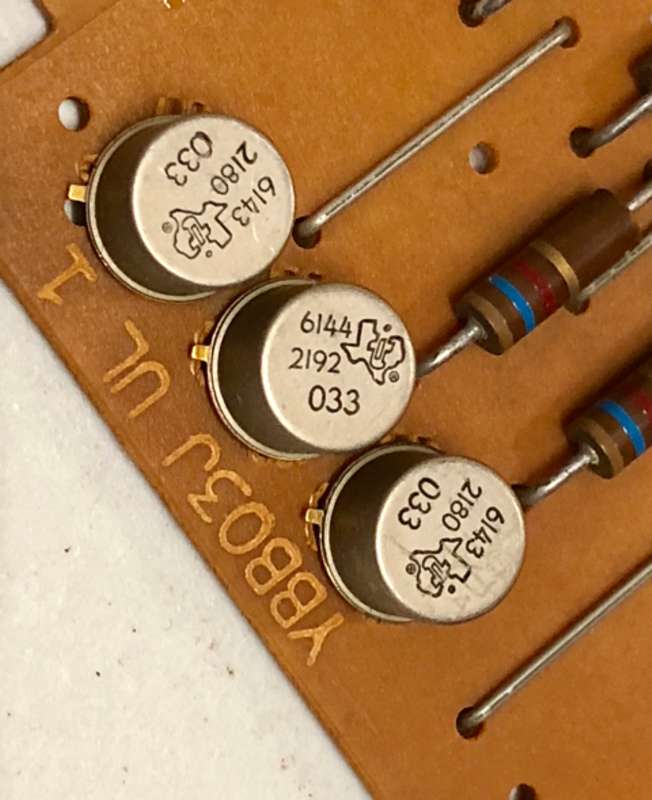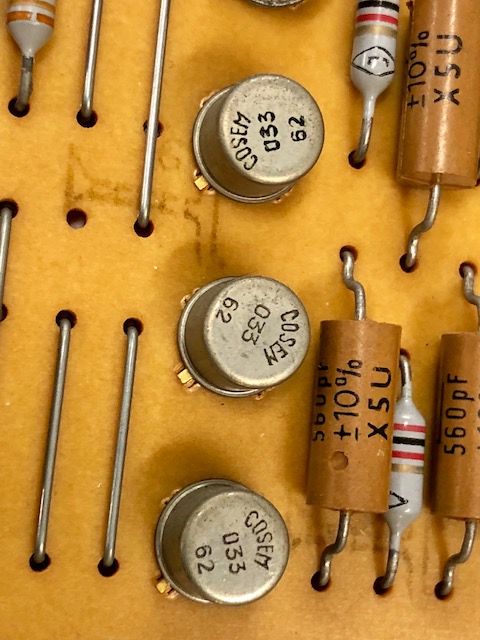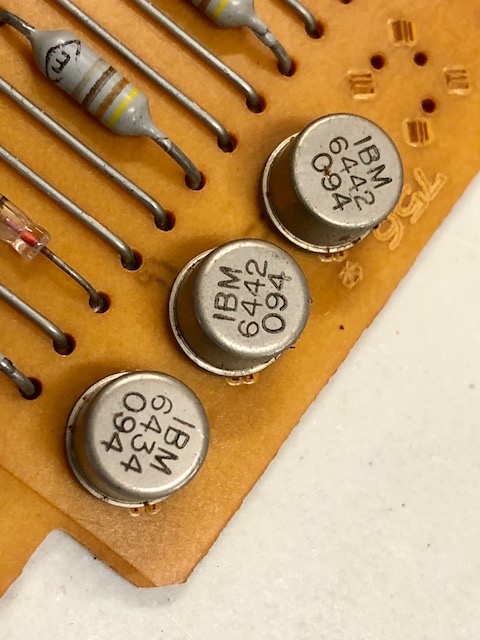firms that manufactured transistors for the IBM 1401
Last update March 10, 2018, below.Below are images of:
Rick Dill’s description of IBM's automated transistor production line
|
In 1958 on returning to IBM, I found that the development group had
built a fully automated factory for producing alloy transistors. It
used syntron sonic driven bowls to feed to germanium die, alloy spheres
for emitter and collector, stub leads soldered to the spheres during
alloying, and the dished base contact washer. These were fed into high
purity carbon fixtures, one for each transistor.
Once the assembly was together it went through a hydrogen furnace, after which the transistor was extracted, etched, washed, dried, tested, and then assembled onto a header. The carbon fixture was sent back to be re-used. We shipped the factory to TI with the stipulation that they could use it only for IBM production for a stated number of years. |
Here are the links to French transistor history (found searching for “COSEM transistor”):
| “History of Transistors in France”: | https://sites.google.com/site/transistorhistory/Home/european-semiconductor-manufacturers/history-of-transistors-in-france |
| “Early French Semiconductors”: | http://www.wylie.org.uk/technology/semics/France/France.htm |
Merc Verdiell e-mailed: - Feb 28, 2018
|
No kidding. They even propose a "proper" French name for transistor, which definitely was sounding way too American: le transitron. Rhymes with the other French inventions: poisson, cochon, electron. Therefore, "my computer uses transistors" becomes the very classy:
"cher Monsieur, mon ordinateur utilise des transitrons". :-) |
Robert Garner responded: - Mar 1, 2018
|
Marc,
Have you seen this Nov, 2005 IEEE Spectrum article: “How Europe Missed the Transistor:”
https://spectrum.ieee.org/tech-history/silicon-revolution/how-europe-missed-the-transistor
“In late 1948, shortly after Bell Telephone Laboratories had announced the invention of the transistor, surprising reports began coming in from Europe. Two physicists from the German radar program, Herbert Mataré and Heinrich Welker, claimed to have invented a strikingly similar semiconductor device, which they called the transistron, while working at a Westinghouse subsidiary in Paris.” |
Rick Dill - Mar 10, 2018
I have NO information about IBM's detail contracts with TI, although I am well aware of the automated "factories". I last saw three of them side by side, running full tile for both IBM and also the rest of the world about 1967. TI was interested in low noise transistors (good to get government contracts) and I was interested in the same thing (germanium) for higher speed (electron and hole mobility) and we worked together cooperatively.
On the other hand, IBM did have a research facility at la Gaude (an amazing location outside of town with a view of the Mediterranean sea. I only visited once and wine was available in the cafeteria line. They also had a factory in Corbeil-Essonne , which included some semiconductor production in later years when I visited. There was good connection between French and US academics in the field, so the transistors could have been made there since both IBM and academics were current with each other. IBM was am international company with skills across the globe, even then. There was also pride that would have accelerated sales in Europe or costs there in the 1401 times.
The transistors were the same and had the same roots in the US with the small crowd of guys I worked with ... a rag tag team of engineers without PhD and technicians who were World War II veterans mostly. Engineers, not scientists, and technicians who taught me the tools I needed to build transistors with my fingers in that time. There were far fewer things to hide a technology with than I had in nano-tech patterning a decade ago. Both were fun times, one in semiconductors and the other in magnetic devices you can buy today.
I have no surprise that 1401's in Europe might have been manufactured there and used different component sources, particularly as the 1401 became an early commodity computer.
Rick
OK, I have been quoted multiple times in this series. I will finally check in..... this retirement stuff is far too busy for kids to have to put up with and that has only peaked this last fall when my wife retired (at the same age as I did, but about a decade later). More travel than I had many years with IBM and not enough time to accomplish personal projects that seem to move slower at an older age. My classic Porsche is sold to younger friend who has energy to fix it up and skills i wish I still had to enjoy driving it. It is good, but this retirement stuff will kill you if you can't keep up.



